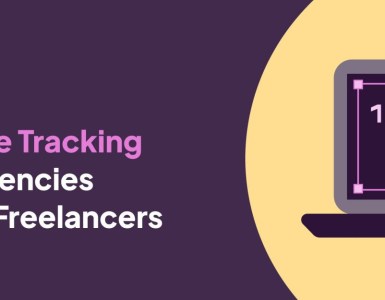There are two main ways that freelancers charge for their services. A rate per hour or a rate per project.
Each method has advantages and disadvantages and is suited to different situations.
So, how do you work out which is best for your project?
What’s an hourly rate?
First things first. An hourly rate is when the freelancer charges you a set rate per hour for their services.
A lot of freelancers go with this method simply because most clients are instantly familiar with how it works.
What’s a per project rate?
A per-project rate is where the freelancer charges a one-time flat fee for the entire project. This means, no matter how long your freelancer spends working on your project, you will only pay the agreed fee.
You might not get to decide:
Here’s an interesting curveball: you might not get to choose whether you pay per hour or per project. Freelancers have established ways of working.
They’ll choose the method that works best for them, and you’ll have to fall in line if you want them to complete your work.
Hourly rate
Pros of charging an hourly rate:
- Depending on the project, this method could offer value for money for you.
- Technically, there’s a limit to the number of hours your freelancer can charge in one day.
- There are only a set number of hours per working day. Meaning, there’s a limit to the number of hours your freelancer can bill you for the work. For example – you have a project which is a small website. Your website will take roughly a day to complete (8 working hours).
Your freelancer’s hourly rate is $85, so that’s $680 in total. The going rate for a small website can be between $400 – $1000.
So in this case an hourly rate could save you money. - If your project needs revisions or amends, they can be charged easily with an hourly rate. It’s harder to calculate how much to charge for revisions if you pay per project.
Cons of charging an hourly rate:
- You don’t know how much the project will cost until it’s done, when you’ll be presented with a final invoice.
You can ask the freelancer to estimate how long they think the project will take, then make a calculation based on this to give you a ballpark figure.
But, of course this is just an estimate. - If the project goes over the deadline, you’ll still be paying per hour and it could end up costing you.
- It can be hard to track what your freelancer is working on.
If they’re working on a lot of projects at once, how do you effectively track time spent on your project? There are tools available that will track what your freelancer’s working on at any given time.
But obviously, these are an additional cost and may overcomplicate a small project - There can be less incentive to get your project done quickly if your freelancer is charging by the hour.
- Hourly rates can be difficult to get your head around. Firstly, they’re often higher than a lot of clients first expect. Freelancers can also have a variety of different hourly rates for the different services they offer
- Lots of clients are drawn in by cheap hourly rates. First time clients often don’t understand why freelancers have such high hourly rates. Therefore, they’re tempted when they see a freelancer with a super cheap hourly rate. But, beware of falling into this trap.
This is often a trick used to lure in unsuspecting clients. The freelancer will take longer to finish your project.
Meaning that in the end you’ve paid just as much, if not more, than you would have if you hired the $120 per hour freelancer, but it’s taken a lot longer. - A disturbingly cheap hourly rate could be a signal that the freelancer turns out bad work. After all, your freelancer should value their professional skills, so why are they charging peanuts for them?
- Keeping track of billed hours is extra organisation and admin for you.
What sort of projects are good for per hourly
Long, ongoing projects. Trying to cost up a project which lasts months, years or longer will be a nightmare…
Per Project Rate
Pros of charging per project:
- You know how much your project is going to cost up front. So, no nasty surprises when you get your final invoice.
- Since your freelancer isn’t being billed for their time, there’s more of an incentive to get your project completed quickly. Then, they can move on to the next project.
- If the project goes over time, you don’t pay any more than the fee you’ve already agreed
Cons of charging per project:
- You’re probably being charged an hourly rate anyway, just rounded up into a lump sum. Freelancers tend to have an hourly base rate in their heads when they cost up projects.
They’ll quickly estimate how long a project will take to complete, then multiply by their hourly rate to come up with their per project figure. This per project rate is often more easily digested by clients than an hourly rate is.
This is all down to the psychology of perceived value.
For example, a simple logo takes a designer 3 hours. Their hourly rate is $80, which means the overall project rate will be $240. When presented with the 2 options, clients often feel more comfortable with $240 than they do with $80 per hour. Presumably because the per hour option is open-ended, whereas a lump sum is certain. - Sometimes clients who pay per project can end up feeling shortchanged. For example, they pay $240 for their logo, and get the finished product back in just 3 hours.
This can leave clients feeling a little like they didn’t get value for money, “How did I just spend so much money on something that only took a couple of hours?”.
Again, this is all down to psychology. If the project took a few more hours to deliver, the client might feel slightly more satisfied. But why? This is simply a sign that your freelancer is a professional and can deliver quality results fast. - If your project needs revisions after it’s completed, these won’t be included in the per project rate. The freelancer will probably offer an hourly fee for any revisions.
What sort of projects are good for a per project rate?
Small to medium projects.
When you want something fast.
When you’re on a tight budget.
Wrapping up
Overall, freelancers are a flexible bunch and will offer a combination of these two pricing structures that suits the needs of the particular project.
Clients who are new to working with freelancers are most worried about being overcharged or taken for a ride by their freelancer. Although there are horror stories out there, it’s highly unlikely your freelancer is trying to rip you off.
Mostly, all they want is to charge their clients a fair price and cover their monthly expenses with a bit left to spare.
Besides, you are worth more to them as a client who can bring repeat work to them. That’s much more valuable than the extra few dollars they could squeeze out of you by overcharging.
Ready to get hired? At Twine, we have dozens of top-quality jobs being posted each and every day. From design to marketing, development to copywriting – there’s a job ready for your skills. Join the marketplace of creative talent here.



